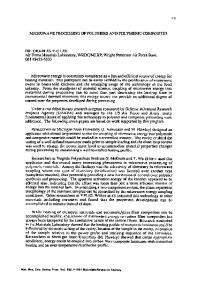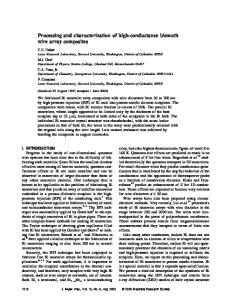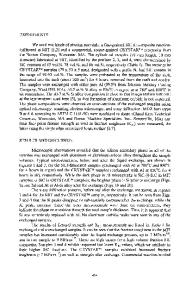Processing of fullerene-reinforced composites
- PDF / 2,031,766 Bytes
- 8 Pages / 576 x 792 pts Page_size
- 90 Downloads / 336 Views
V. Provenzano Materials Science & Technology Division, Code 6323, Naval Research Laboratory, Washington, DC 20375-5000
J. Milliken Chemistry Division, Code 6120, Naval Research Laboratory, Washington, DC 20375-5000
R.L. Holtz Geo-Centers, Inc., Fort Washington, Maryland 20744 (Received 12 January 1994; accepted 21 June 1994)
This work has been motivated by the current interest in using fullerenes as a possible reinforcement in structural materials. The fullerenes (of which C60 is the most common) are nanometer in size and have been observed to be stable in contact with various metal systems. Therefore, they offer a nanosize reinforcement that is lightweight and hollow. In this research the emphasis was on processing metals with fullerene additions where the fullerenes were dispersed throughout the metal. Various processing approaches were employed to produce nanocrystalline materials, thin films, and powder-processed composites. Indications are that fullerenes remained unaltered with each processing approach in matrices of tin, copper, and aluminum. A key aspect of the processing of metals containing dispersed fullerenes was the use of fullerene sublimation. Along with the various processing methods identified, the methods of characterizing the fullerenes in the metals were also identified.
I. INTRODUCTION Fullerenes (of which C60 is the most common) 12 can be considered new and unique reinforcements for composite systems where enhancements in mechanical properties are sought by dispersing these nanosize particles in the matrix of interest. Their role as a reinforcement is dependent on whether or not they remain unaltered through the processing and service life. In the unreacted case, fullerenes may enhance strength and damping while in the reacted state they are precursors to in situ reinforced composites. The use of crystalline fullerene, as a possible reinforcement, has not been considered by other investigators because of the van der Waals bonding between the individual C60 molecules, even though in compression crystalline C60 has been shown to remain stable.3'4 Molecular dynamic studies of the individual molecules5 have suggested that dispersed fullerenes would lead to structural enhancements by dispersion strengthening 67 and enhanced damping because of the open volume (3.5 A diameter pore size) of the C60 molecules.8'9 Further motivation for this work has been the ability to produce fullerenes in macroscopic quantities.10 Where material and processing costs determine the usefulness of new materials currently 2662 http://journals.cambridge.org
J. Mater. Res., Vol. 9, No. 10, Oct 1994
Downloaded: 16 Mar 2015
being developed for structural applications, demonstration of the ability to process fullerenes in metals by a number of approaches will enhance the likelihood of producing a low cost fullerene-reinforced material. The present work is directed toward synthesis of metals containing dispersed fullerenes and evaluating the properties of the dispersed phase. Yeoh et al.,u when studying fullerene-reinfor
Data Loading...











